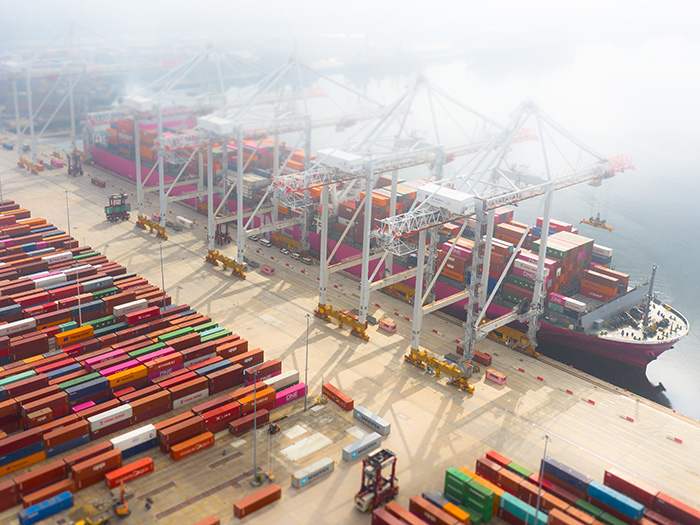As Supply Chain Risks Persist, Specialized Insurance Just Might See Its Day in the Sun

You don’t have to walk very far to hear someone griping about supply chains these days.
Well, not the supply chain per se, but any complaint about soaring gas prices, empty store shelves or how much it costs to buy a car is linked to backstops in global supply chains.
Russia’s war on Ukraine, the ongoing COVID-19 pandemic, labor shortages and shipping backlogs on the United States’ East and West coasts have all contributed to shortages that caused Risk & Insurance® to dub supply chain issues “a surprise menace in 2021.”
“My feeling is that the recent events — COVID, increased climate events and exposures, global conflict, etc. — are putting stress on supply chains that have gotten increasingly complex over time,” said Cole Mayer, senior structurer for Swiss Re Corporate Solutions.
Aluminum, plastics, raw building materials and food products are all expected to be in short supply this year, Supply Chain Drive predicted in January of 2022.
The ongoing semiconductor shortage has gotten so bad that Congress recently passed the CHIPS Act, which provides $52 billion in funding to spur research, workforce development and U.S. manufacturing of the chips that are in everything from laptops and cellphones to cars and refrigerators.
With supply chain risks likely to remain top-of-mind for years to come, businesses are beginning to see the value of specialized supply chain insurance policies, especially since they may be finding their contingent business interruption (CBI) policies lacking.
Supply Chain Issues Have Been a Threat for Years
Supply chain risk isn’t new. In fact, it’s been steadily increasing over the years as businesses pivoted to just-in-time delivery and began reducing their warehouse stock.
“Supply chain losses are not a new situation,” said Brian Mazick, all-risk underwriting manager, FM Global. “This is something that has been a problem for clients to deal with for years, and it is getting more complicated all the time.”
As two-day shipping and instant delivery options grew in popularity, businesses began optimizing their supply chains for speed, often relying on only a handful of suppliers and reducing their warehouse stock.
“You’ve seen a lot of industry segments optimize supply chains, which is good in the short term from a cost perspective, but it sometimes creates unforeseen risk that isn’t as adequately managed or understood,” Mayer said.
Global trade has made the situation even more complex: “The excitement about supply chain is really fairly new, in terms of that it’s a global issue now,” Steven Press, attorney at law firm Baker Donelson, said. “Historically, it’s been more localized to a geography or to perhaps a certain type of product. But at the moment, it’s basically worldwide.”
One of the reasons risks used to be localized to particular properties is that many supply chain issues are the result of damage to physical warehouse or products, usually caused by severe weather events.
In the past, when enterprises thought about hardening their supply chains, they would use natural hazard exposures and ensure their suppliers weren’t concentrated solely in one particular area that could be exposed to flooding or earthquakes.
Carriers developed tools to help clients understand the severe weather risks particular suppliers face, and companies purchased products like CBI that dovetailed with their risk management efforts.
“We have a natural hazard toolkit that has information globally about the exposures of flood and earthquake and hail, so people can understand what exposures might exist in parts of the world they don’t normally do business in,” Mazick explained.
Over the past five years, the number of CBI claims has continued to climb. Last year’s semi-conductor shortage and Texas’ winter freeze caused filed CBI claims to more than triple over the previous three years, per Allianz Global Corporate & Specialty’s 2022 Global Claims Review.
We Were Prepared … and then COVID Happened
Today’s supply chain risks don’t always fit into the seamless risk management and transfer model CBI policies are designed for. CBI is often triggered by physical losses to a building, and there are often exclusions for delays that don’t result from material damage, either to a building or a product.
Simply put: Delays resulting from factory closures due to COVID-19 outbreaks or other staffing shortages aren’t covered perils.
“We’ve been talking with customers for years about how do you harden a supply chain?” said Will Porter, head of international programs, Americas, for Swiss Re Corporate Solutions. “But this isn’t a facility going down or a hurricane or typhoon hitting a region. We don’t have the people who can actually move the goods from point A to point B.”
Labor shortages and COVID-19 shutdowns in particular are difficult to predict, leaving companies feeling unsure of whether their supplies will be able to deliver the promised materials or not.
“One of the biggest things that I’ve seen as I’ve spoken with our customers is they just don’t know what to expect from their suppliers,” Porter said.
This uncertainty will continue so long as the COVID-19 virus continues to rapidly evolve and rip through populations around the world. As the Omicron variant spread in late 2021, China’s zero-COVID policy led to shutdowns in multiple cities, thereby causing factory closures that burdened already-strained supply chains, Bloomberg reported in January.
Now, as Omicron has evolved with the hyper-contagious subvariants BA.4 and BA.5, more waves of infection are likely to lead to further closures.
“China’s zero-COVID policy is really putting a lot of pressure on companies that have inputs, or products, coming out of China,” said Lee Smith, attorney and leader of law firm Baker Donelson’s international trade and national security practice.
Insurance to the Rescue
One way businesses are responding to these increased risks is through purchasing specialized supply chain insurance. Designed to cover losses caused by events ranging from cyberattacks and political instability to transportation failures and labor shortages, the policies previously experienced tepid uptake from insureds.
Policies purchased in the near-term won’t cover losses insureds have faced over the past few years, however. Some businesses will pass the costs of these losses on to consumers, through price increases. “Between energy, food and consumer products, I think all are going to be hitting the pocket books of the American consumer,” Smith said.
Smith believes one way businesses may try to afford major price hikes is through “skimp-flation, where prices are increased a little bit, but you get a little bit less in each serving,” he said.
Still, companies are paying more attention to their supply chain risks now than they did in years past. From COVID-19 to storms caused by global climate change, none of the risks we’re currently facing are going away anytime soon. Businesses will need to become more resilient in order to survive and part of that means protecting every facet of their supply chains.
“There’s a lot more excitement about and more of an interest in purchasing CBI and supply chain coverage,” Press said. “More businesses will be purchasing supply chain insurance when things next become good, than they did prior to the pandemic.” &










